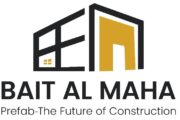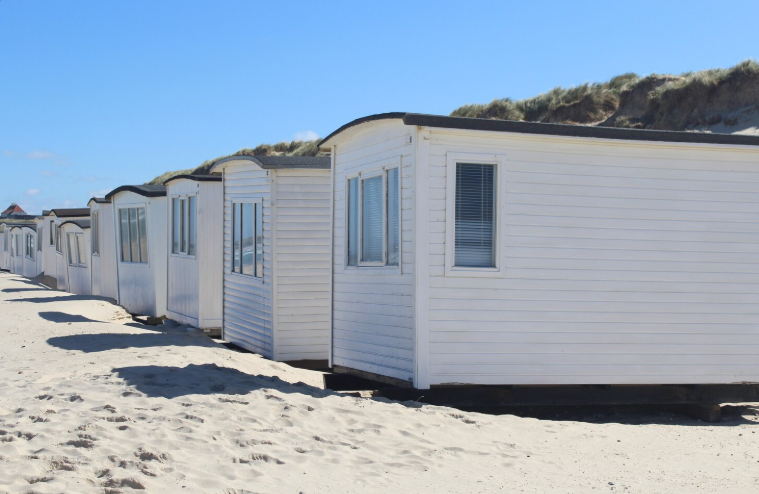Sandwich panel cabin have become essential in Dubai’s fast-paced construction sector, offering a versatile, eco-friendly solution for various applications, from temporary offices to permanent residential and industrial facilities. These cabins are composed of two outer metal layers with an insulating core, providing thermal efficiency and durability, crucial for Dubai’s extreme climate, characterized by high temperatures, humidity, and frequent sandstorms.
In Dubai, where rapid urban development and sustainability are key priorities, sandwich panel cabin address the need for speed, scalability, and energy efficiency. Their lightweight and modular design allows for quick assembly, often within hours, and easy relocation, making them suitable for both temporary and long-term use. With cooling systems consuming a significant portion of energy, the superior insulation of sandwich panel cabin helps reduce energy costs, supporting Dubai’s vision for sustainable, green building practices.
These cabins are built to withstand Dubai’s harsh weather conditions, with insulation that minimizes heat transfer and materials that resist wear from sandstorms. Their lightweight structure also reduces the need for heavy foundations, minimizing environmental impact and speeding up construction timelines. Additionally, their versatility makes them ideal for a range of uses, such as worker accommodations in remote desert sites or cold storage in logistics hubs.
Overall, sandwich panel cabin provide a practical and sustainable solution, addressing Dubai’s unique environmental and logistical challenges while contributing to the nation’s ambitious infrastructure goals. Their applications are set to grow as Dubai continues its focus on innovation and sustainability in construction.
What is a Sandwich Panel Cabin?
Sandwich panel cabin is a prefabricated structure built using sandwich panels, which are composite materials consisting of two outer layers, typically made of metal such as galvanized steel or aluminum, bonded to an insulating core. These panels are engineered to provide a balance of strength, insulation, and lightweight construction, making them ideal for modular buildings in DUBAI’s demanding climate. The cabins are used across various sectors, including construction, industrial, residential, and commercial, due to their versatility, rapid assembly, and energy-efficient properties.
Composition and Structure
A sandwich panel consists of three primary components:
- Outer Layers (Skins): Typically made of galvanized steel or aluminum, these layers provide structural integrity and protection against environmental factors like UV radiation, humidity, and sandstorms. The metal is often coated with anti-corrosive materials, such as polyester or PVDF (polyvinylidene fluoride), to enhance durability in DUBAI’s coastal and desert environments.
- Insulating Core: The core is the heart of the sandwich panel, offering thermal insulation, soundproofing, and, in some cases, fire resistance. Common core materials include:
- Polyurethane (PU): A lightweight foam with excellent thermal insulation (R-value ~0.024 W/m·K), ideal for maintaining cool indoor environments in DUBAI’s heat.
- Polyisocyanurate (PIR): An advanced foam with superior fire resistance and slightly better insulation than PU, often used in high-safety applications.
- Rockwool: A mineral wool core made from molten rock, offering exceptional fire resistance (up to 1000°C), sound insulation, and eco-friendliness.
- Expanded Polystyrene (EPS): A lightweight, cost-effective foam with moderate insulation properties, suitable for less demanding applications.
- Honeycomb: A hexagonal structure, often made of aluminum or polypropylene, used for lightweight applications like interior partitioning.
- Bonding: The skins and core are bonded using high-strength adhesives or mechanical fastening, ensuring a robust, airtight panel.
Panel thickness varies from 30 mm to 200 mm, depending on the insulation and structural requirements. Standard widths range from 1,000 to 1,200 mm, with lengths up to 15 meters, allowing for customization to suit specific project needs. In DUBAI, panels are designed to withstand extreme weather, with coatings that resist corrosion from saline air and sand abrasion.
Key Features
Sandwich panel cabin offers a range of features tailored to the DUBAI’s needs:
- Thermal Insulation: The core materials minimize heat transfer, reducing cooling energy consumption by up to 60% compared to traditional materials.
- Fire Resistance: PIR and Rockwool cores meet stringent fire safety standards, critical for industrial and commercial applications.
- Sound Insulation: Rockwool and PU cores provide acoustic damping, ideal for noisy environments like construction sites or industrial zones.
- Durability: The metal skins are resistant to corrosion, UV radiation, and mechanical damage, ensuring a lifespan of 40+ years with proper maintenance.
- Modularity: Panels are prefabricated, enabling rapid assembly and disassembly, which is ideal for temporary structures or projects requiring relocation.
- Lightweight Design: The low weight reduces foundation requirements, making cabins suitable for remote or unstable terrains.
Manufacturing Process
The production of sandwich panels involves advanced techniques to ensure quality and consistency:
- Metal Preparation: Steel or aluminum sheets are cut, cleaned, and coated with protective layers to resist corrosion and weathering.
- Core Injection: The insulating core (e.g., PU or PIR foam) is injected or bonded between the metal skins using automated systems for precision.
- Pressing and Curing: Panels are pressed under controlled conditions to ensure a strong bond, then cured to achieve structural integrity.
- Finishing: Panels are cut to size, sealed with weather-resistant edges, and coated for enhanced durability.
In DUBAI, manufacturers adhere to international standards like ISO 9001 for quality management, ensuring panels meet local regulatory requirements for energy efficiency and safety. The process is highly automated, allowing for consistent production and customization to meet project-specific needs.
DUBAI-Specific Considerations
In DUBAI, sandwich panel cabin are designed to address local challenges:
- Climate: The insulating cores combat extreme heat, reducing reliance on air conditioning and supporting DUBAI’s sustainability goals.
- Regulations: Panels comply with standards set by Dubai Municipality, Abu Dhabi Quality and Conformity Council, and Estidama, ensuring energy efficiency and safety.
- Versatility: The modular design supports rapid deployment in urban and remote areas, from Dubai’s skyscraper zones to Abu Dhabi’s industrial parks.
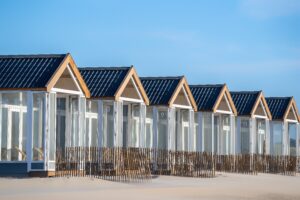
History and Evolution of Sandwich Panel Cabin
The development of sandwich panel cabin traces back to the mid-20th century, when composite materials were first explored for aerospace applications. Over the decades, these materials transitioned into construction, becoming a staple in modular building solutions. In DUBAI, sandwich panel cabin have evolved to meet the demands of rapid urbanization, extreme climate, and sustainability goals, playing a pivotal role in the nation’s construction landscape.
Origins in Aerospace
Sandwich panels were initially developed in the 1950s for aerospace applications, where lightweight, strong materials were essential for aircraft construction. The concept involved bonding two thin, high-strength skins to a lightweight core, creating a composite with an exceptional strength-to-weight ratio. Early cores included honeycomb structures made of aluminum or paper, used in aircraft wings and fuselages. By the 1970s, the construction industry recognized the potential of these materials for buildings, particularly for their insulation and modularity.
Adoption in Construction
The transition to construction began with the use of sandwich panels in industrial buildings, where their insulation properties and ease of assembly offered advantages over traditional materials like concrete and brick. Early panels used EPS cores, which provided basic insulation but lacked fire resistance. The 1980s saw the introduction of PU and PIR foams, which improved thermal efficiency and safety, making sandwich panels suitable for a wider range of applications, including residential and commercial structures.
Emergence in Dubai
In Dubai, sandwich panel cabin gained prominence in the early 2000s, driven by the country’s construction boom. Mega-projects, such as skyscrapers, malls, and industrial zones, required fast, scalable building solutions. Sandwich panel cabin became a go-to choice for temporary structures like site offices and worker accommodations, thanks to their rapid assembly and portability. Their ability to withstand Dubai’s harsh climate—characterized by extreme heat, humidity, and sandstorms—made them particularly appealing.
Material Advancements
The evolution of sandwich panel cabin in Dubai reflects advancements in materials and manufacturing:
- 1970s–1980s: EPS cores dominated early panels, offering cost-effective insulation but limited fire resistance.
- 1990s: PU and PIR foams improved thermal efficiency and safety, meeting stricter building codes.
- 2000s: Rockwool cores gained popularity for their fire resistance and eco-friendliness, aligning with DUBAI’s sustainability goals.
- 2010s–Present: Innovations like bio-based cores, advanced coatings, and automated production have enhanced durability and customization.
In DUBAI, the shift toward sustainable materials like Rockwool and autoclaved aerated concrete (AAC) reflects the nation’s focus on reducing environmental impact. Advanced coatings, such as PVDF, protect panels from corrosion in coastal areas, while automated production ensures precision and scalability.
Impact on DUBAI Construction
Sandwich panel cabins have transformed the Dubai construction sector by enabling rapid, efficient, and sustainable building solutions. Their modular nature supports the country’s fast-paced development, from temporary housing for workers to permanent facilities in industrial zones. The evolution of these cabins aligns with DUBAI’s vision for innovative, eco-friendly construction, with ongoing research into advanced materials and smart technologies shaping their future.
Applications of Sandwich Panel Cabin in DUBAI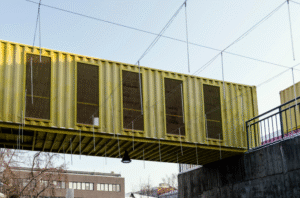
Sandwich panel cabins are exceptionally versatile, serving a wide range of applications in DUBAI due to their modularity, durability, and insulation properties. From construction sites to industrial facilities, these cabins address diverse needs while meeting the region’s environmental and regulatory challenges. Below is a detailed exploration of their primary applications.
Construction Site Offices
Sandwich panel cabins are a preferred choice for temporary offices on construction sites across DUBAI. Their modular design allows for assembly within 7–8 hours, providing immediate workspace for project managers, engineers, and supervisors. The cabins are equipped with high-performance insulation to maintain comfortable indoor temperatures, critical in DUBAI’s scorching climate. Features like soundproofing ensure a quiet working environment, even in noisy construction zones. Customizable with windows, doors, electrical fittings, and HVAC systems, these cabins serve as fully functional offices that can be relocated as projects move to new sites.
Labor Accommodations
DUBAI’s large-scale infrastructure projects, such as bridges, highways, and urban developments, require housing for thousands of workers, often in remote desert locations. Sandwich panel cabin provide durable, insulated accommodations that meet worker welfare standards. These cabins are designed with ventilation, lighting, and sanitation facilities, ensuring a safe and comfortable living environment. Their lightweight construction and modularity allow for easy transport and reconfiguration, making them ideal for temporary housing that can be dismantled and reused across multiple projects.
Cold Storage Units
DUBAI’s growing logistics and food sectors rely on cold storage facilities to preserve perishable goods, such as food and pharmaceuticals. Sandwich panel cabin with PIR or PU cores offer superior thermal insulation, maintaining consistent low temperatures while minimizing energy consumption. These cabins are airtight, preventing air leaks and ensuring hygiene in sensitive environments. Their durability and resistance to moisture make them suitable for long-term use in refrigerated warehouses, supporting DUBAI’s role as a global logistics hub.
Residential and Commercial Structures
Sandwich panel cabin are increasingly used for residential and commercial applications, including modular homes, retail kiosks, and small office buildings. In residential settings, they offer affordable, energy-efficient housing solutions, particularly in rapidly developing areas like Dubai and Abu Dhabi. For commercial use, cabins serve as pop-up shops, cafes, or exhibition spaces, with customizable designs that allow for aesthetic appeal. Their insulation properties reduce cooling costs, while their modular nature supports quick deployment in urban and suburban settings.
Specialized Applications
Sandwich panel cabins are also used in specialized environments:
- Clean Rooms: Used in pharmaceuticals and electronics, these cabins provide sterile, dust-free environments with airtight seals and high insulation.
- Data Centers: Their thermal efficiency and fire resistance make them suitable for housing sensitive IT equipment.
- Solar Energy Facilities: Lightweight cabins serve as control rooms or worker accommodations in remote solar farms, withstanding desert conditions.
DUBAI-Specific Applications
In DUBAI, sandwich panel cabin are tailored to local needs:
- Desert Environments: Panels are designed to resist sand abrasion and UV radiation, ensuring durability in remote sites.
- Urban Projects: Their rapid assembly supports DUBAI’s fast-paced urban development, from temporary event spaces to permanent retail structures.
- Sustainability Goals: The use of eco-friendly cores like Rockwool aligns with green building initiatives, reducing environmental impact.
Benefits of Sandwich Panel Cabin in Dubai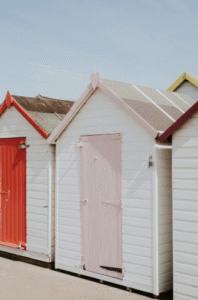
Sandwich panel cabins offer a multitude of benefits that make them an ideal choice for construction in DUBAI. Their unique properties address the region’s environmental, logistical, and regulatory challenges, providing efficient, sustainable, and durable building solutions.
Energy Efficiency
In DUBAI, where cooling systems account for a significant portion of energy consumption, sandwich panel cabin excel in thermal insulation. The core materials, such as PU, PIR, and Rockwool, have high R-values (0.024–0.05 W/m·K), minimizing heat transfer and maintaining stable indoor temperatures. This reduces reliance on air conditioning, lowering energy consumption by up to 60% compared to traditional materials like concrete. The airtight design of the panels prevents air leaks, further enhancing energy efficiency and supporting DUBAI’s sustainability goals.
Durability and Weather Resistance
DUBAI’s harsh climate, characterized by extreme heat, humidity, and sandstorms, demands robust building materials. Sandwich panel cabins are constructed with corrosion-resistant metal skins, often coated with PVDF or polyester to withstand UV radiation and saline air. The panels are engineered to resist mechanical damage and abrasion from sand, ensuring a lifespan of over 40 years with minimal maintenance. Their structural integrity makes them suitable for both urban and remote environments, from coastal cities to desert sites.
Cost-Effectiveness
The lightweight nature of sandwich panel cabin reduces the need for heavy foundations, lowering construction costs and timelines. Their prefabricated design allows for rapid assembly, often completed within a day, minimizing labor requirements. The modularity of the cabins enables reuse and relocation, making them a cost-effective solution for temporary structures like site offices or worker accommodations. Additionally, their energy efficiency reduces long-term operational costs, particularly for cooling.
Sustainability
Sandwich panel cabins align with DUBAI’s commitment to sustainable development, as outlined in initiatives like Estidama and national visions for eco-friendly construction. Cores like Rockwool and AAC are made from recyclable or natural materials, reducing environmental impact. The lightweight design minimizes resource use during construction, while the energy-efficient properties lower carbon emissions over the building’s lifespan. Some panels incorporate bio-based cores, further enhancing their eco-friendliness.
Fire Resistance
Safety is a priority in DUBAI, where stringent fire regulations govern construction. PIR and Rockwool cores offer excellent fire resistance, withstanding temperatures up to 1000°C and delaying fire spread. These properties make sandwich panel cabins suitable for high-risk environments like industrial facilities and cold storage units, ensuring compliance with local safety standards.
Sound Insulation
DUBAI’s bustling construction sites and industrial zones generate significant noise, which can affect worker productivity and comfort. Sandwich panel cabins with Rockwool or PU cores provide superior sound insulation, reducing noise levels by up to 30–40 dB. This makes them ideal for site offices, labor accommodations, and urban settings where noise pollution is a concern.
Modularity and Flexibility
The modular design of sandwich panel cabins allows for easy assembly, disassembly, and reconfiguration. This flexibility supports DUBAI’s dynamic construction needs, enabling cabins to be relocated across project sites or repurposed for different uses. The panels can be customized in size, color, and texture, offering aesthetic versatility for commercial and residential applications.
Top Sandwich Panel Cabin Suppliers in Dubai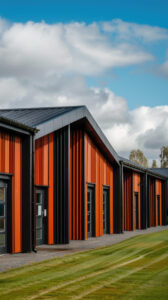
This section provides a detailed overview of the key considerations for evaluating suppliers of sandwich panel cabins in DUBAI, focusing on product quality, certifications, and service offerings without naming specific companies. The Dubai sandwich panel market is highly competitive, with suppliers offering a range of products tailored to local needs, from fire-resistant panels to eco-friendly designs.
Key Considerations for Choosing Suppliers
When selecting a supplier for sandwich panel cabins, several factors are critical:
- Product Range: Suppliers should offer diverse panel types, including PU, PIR, Rockwool, EPS, and honeycomb cores, to suit various applications like roofing, cladding, and partitioning.
- Certifications: Look for suppliers adhering to international standards like ISO 9001 for quality management and local regulations such as Dubai Civil Defence (DCD) for fire safety.
- Customization: The ability to tailor panels in terms of size, thickness, color, and texture is essential for meeting project-specific requirements.
- Delivery and Installation: Suppliers should provide efficient delivery and certified installation services to ensure project timelines are met.
- After-Sales Support: Comprehensive support, including maintenance guidance and warranty options, enhances long-term reliability.
Panel Types and Applications
Suppliers in DUBAI offer a variety of sandwich panels, each suited to specific applications:
- PU and PIR Panels: Used for cold storage and residential cabins due to their high thermal insulation and fire resistance.
- Rockwool Panels: Preferred for industrial and high-safety environments, offering sound insulation and eco-friendliness.
- EPS Panels: Common in cost-sensitive projects like temporary site offices.
- Honeycomb Panels: Used for lightweight partitioning in commercial spaces.
Certifications and Standards
The Dubai construction sector is governed by strict regulations, requiring suppliers to meet standards for energy efficiency, fire safety, and structural integrity. Key certifications include:
- ISO 9001: Ensures consistent quality in manufacturing processes.
- Dubai Civil Defence (DCD): Verifies fire resistance for PIR and Rockwool panels.
- Estidama: Aligns with DUBAI’s sustainability framework, emphasizing energy-efficient materials.
- FM Approvals: Validates performance in fire and environmental testing.
Suppliers should provide documentation to confirm compliance, ensuring panels meet DUBAI’s building codes for urban and industrial projects.
Service Offerings
Top suppliers differentiate themselves through comprehensive services:
- Design and Engineering: Offering technical support for panel selection and project planning.
- Delivery: Providing doorstep delivery across the Emirate of Dubai, from Dubai to Ras Al Khaimah.
- Installation: Employing certified contractors to ensure proper assembly and compliance with safety standards.
- Maintenance Support: Offering guidance on panel upkeep to extend lifespan and performance.
Comparison Framework
To evaluate suppliers, consider the following framework:
- Product Quality: Assess the durability, insulation, and weather resistance of panels.
- Customization Options: Ensure suppliers can meet aesthetic and functional requirements.
- Project Experience: Look for a track record in diverse applications, such as industrial warehouses, residential units, or cold storage facilities.
- Service Reliability: Evaluate delivery timelines, installation expertise, and after-sales support.
Market Trends in the DUBAI Sandwich Panel Cabin Industry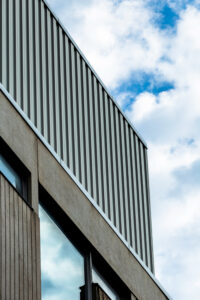
The Dubai sandwich panel cabin industry is evolving rapidly, driven by the country’s focus on sustainable development, rapid urbanization, and technological advancements. This section explores key trends shaping the industry, providing insights into current and future directions without referencing market values or specific companies.
Sustainability and Eco-Friendly Materials
DUBAI’s commitment to sustainability, as outlined in initiatives like Estidama and national visions, has driven demand for eco-friendly sandwich panel cabins. Trends include:
- Eco-Friendly Cores: Rockwool and autoclaved aerated concrete (AAC) are gaining popularity due to their recyclability and low environmental impact.
- Low-Carbon Manufacturing: Advances in production reduce energy consumption and emissions, aligning with green building standards.
- Recyclable Panels: Panels designed for disassembly and reuse support circular economy principles, reducing construction waste.
Technological Advancements
Innovations in manufacturing and design are enhancing the performance of sandwich panel cabin:
- Automated Production: High-precision automated lines ensure consistent quality and scalability, meeting DUBAI’s high demand for modular buildings.
- Smart Insulation: Panels with integrated sensors monitor temperature and humidity, optimizing energy use in smart buildings.
- 3D Printing: Emerging technologies allow for customized panel designs, enabling complex architectural forms.
Demand for Modular Construction
DUBAI’s fast-paced development, from urban skyscrapers to remote industrial zones, has increased demand for modular construction. Sandwich panel cabins support this trend by:
- Reducing Construction Time: Prefabricated panels enable rapid assembly, critical for meeting tight project deadlines.
- Supporting Scalability: Modular designs allow for easy expansion or relocation, ideal for dynamic projects like event spaces or worker accommodations.
- Enhancing Flexibility: Panels can be reconfigured for different uses, from temporary site offices to permanent commercial structures.
Growth in Specialized Applications
The versatility of sandwich panel cabin has led to their adoption in niche sectors:
- Cold Storage: The DUBAI’s logistics sector relies on insulated panels for refrigerated warehouses, supporting the country’s role as a global trade hub.
- Clean Rooms: Pharmaceutical and electronics industries use panels for sterile environments, leveraging their airtight and hygienic properties.
- Renewable Energy: Cabins serve as control rooms or accommodations in solar and wind farms, withstanding harsh desert conditions.
Alignment with Regulatory Frameworks
DUBAI’s stringent building codes emphasize energy efficiency, fire safety, and sustainability. Sandwich panel cabin are evolving to meet these standards:
- Energy Efficiency: Improved insulation reduces cooling energy consumption, supporting compliance with Estidama and Dubai Green Building Regulations.
- Fire Safety: PIR and Rockwool panels meet Dubai Civil Defence standards, ensuring safety in high-risk environments.
- Structural Integrity: Panels are tested for wind resistance and seismic stability, critical for DUBAI’s diverse terrains.
Technical Specifications of Sandwich Panel Cabin
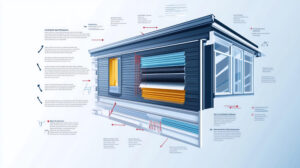
Sandwich panel cabins are engineered with precise technical specifications to meet DUBAI’s construction requirements. This section provides a detailed breakdown of their properties, ensuring professionals understand their performance and applications.
Panel Dimensions
- Thickness: Ranges from 30 mm to 200 mm, depending on insulation needs. Thicker panels (100–200 mm) are used for cold storage, while thinner panels (30–50 mm) suit partitioning.
- Width: Typically 1,000–1,200 mm, ensuring compatibility with standard construction frameworks.
- Length: Up to 15 meters, allowing for large, seamless panels that reduce joints and improve insulation.
Material Properties
- Outer Skins: Galvanized steel (0.5–0.7 mm thick) or aluminum (0.7–1.0 mm), coated with PVDF or polyester for corrosion resistance. Steel offers higher strength, while aluminum is lighter and more resistant to saline environments.
- Core Materials:
- PU: Density 40–45 kg/m³, thermal conductivity ~0.024 W/m·K, suitable for general insulation.
- PIR: Density 40–50 kg/m³, thermal conductivity ~0.022 W/m·K, fire resistance up to 2 hours.
- Rockwool: Density 100–150 kg/m³, thermal conductivity ~0.04 W/m·K, fire resistance up to 4 hours, sound reduction up to 40 dB.
- EPS: Density 15–25 kg/m³, thermal conductivity ~0.035 W/m·K, cost-effective but less fire-resistant.
- Honeycomb: Density varies (e.g., 20–80 kg/m³ for aluminum), used for lightweight applications.
Performance Metrics
- Thermal Insulation: R-values range from 0.024 W/m·K (PU/PIR) to 0.05 W/m·K (Rockwool), reducing heat transfer in DUBAI’s hot climate.
- Fire Resistance: PIR and Rockwool panels meet Class A fire ratings, withstanding temperatures up to 1000°C.
- Sound Insulation: Rockwool panels reduce noise by 30–40 dB, ideal for industrial and urban settings.
- Load-Bearing Capacity: Panels support distributed loads of 0.5–2.5 kN/m², depending on thickness and core type.
- Weather Resistance: Coated skins resist UV radiation, humidity, and sand abrasion, ensuring durability in the DUBAI’s environment.
Testing and Standards
Panels are tested for:
- Thermal Performance: Measured via ASTM C518 for thermal conductivity.
- Fire Resistance: Tested under EN 13501-1 for reaction to fire.
- Structural Integrity: Evaluated for wind and seismic loads per DUBAI building codes.
- Durability: Accelerated weathering tests simulate DUBAI’s climate, ensuring long-term performance.
Customization Options
Panels can be customized in:
- Color: RAL color options for aesthetic integration.
- Texture: Smooth, corrugated, or embossed finishes.
- Edge Design: Tongue-and-groove or cam-lock systems for airtight assembly.
How to Choose the Right Sandwich Panel Cabin Supplier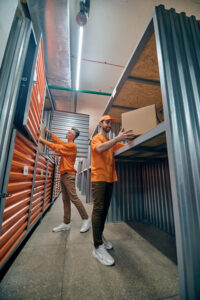
Selecting a supplier for sandwich panel cabins in DUBAI requires careful consideration of quality, compliance, and service offerings. This section provides a comprehensive guide to making informed decisions without referencing specific companies.
Key Selection Criteria
- Product Quality: Ensure panels use high-grade materials (e.g., galvanized steel, PIR cores) and meet international standards like ISO 9001.
- Certifications: Verify compliance with DUBAI regulations, including Dubai Civil Defence (fire safety), Estidama (sustainability), and Abu Dhabi Quality and Conformity Council standards.
- Customization: Choose suppliers offering tailored solutions, such as variable panel sizes, colors, and core types, to meet project-specific needs.
- Delivery and Installation: Prioritize suppliers with efficient logistics and certified installation teams to ensure timely and safe assembly.
- After-Sales Support: Look for comprehensive maintenance guidance, warranties, and technical support to ensure long-term performance.
Evaluating Panel Types
Different applications require specific panel types:
- Cold Storage: PIR or PU panels for high insulation and airtight seals.
- Industrial Facilities: Rockwool panels for fire resistance and sound insulation.
- Temporary Structures: EPS panels for cost-effective, lightweight solutions.
- Commercial Spaces: Honeycomb or PU panels for aesthetic flexibility and lightweight partitioning.
Assessing Supplier Capabilities
- Manufacturing Expertise: Suppliers should use automated production lines for precision and scalability, ensuring consistent quality.
- Technical Support: Look for engineering and design services to assist with panel selection and project planning.
- Project Experience: Evaluate suppliers based on their track record in diverse applications, such as residential, industrial, or cold storage projects.
- Logistics: Ensure suppliers can deliver across the DUBAI’s emirates, from urban Dubai to remote Ras Al Khaimah, with minimal delays.
Practical Checklist
- Verify Certifications: Request documentation for ISO 9001, DCD, and Estidama compliance.
- Assess Material Quality: Check specifications for core density, thermal conductivity, and fire resistance.
- Evaluate Customization: Confirm options for size, color, and texture to meet project aesthetics.
- Review Service Offerings: Ensure delivery, installation, and maintenance support are available.
- Check References: Seek evidence of successful projects in similar applications.
Installation Process for Sandwich Panel Cabin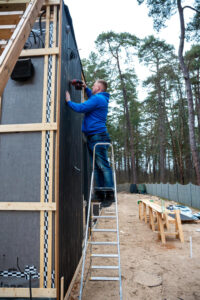
The installation of sandwich panel cabin is a streamlined process that leverages their modular design to achieve rapid, efficient construction. This section outlines the steps, tools, and best practices for installing these cabins in DUBAI, ensuring compliance with local standards.
Installation Steps
- Site Preparation:
- Clear and level the site to ensure a stable foundation.
- Install a concrete or steel base for load distribution, tailored to DUBAI’s terrain (e.g., desert sand or urban concrete).
- Verify site accessibility for panel delivery and crane operations.
- Panel Delivery and Handling:
- Transport panels in protective packaging to prevent damage from sand or humidity.
- Use cranes or forklifts to unload panels, ensuring careful handling to avoid dents or coating damage.
- Assembly:
- Position panels using tongue-and-groove or cam-lock systems for airtight joints.
- Secure panels to the foundation or framework with screws or bolts, ensuring alignment.
- Install windows, doors, and HVAC systems as per design specifications.
- Sealing and Finishing:
- Apply weather-resistant sealants to joints to prevent air and water infiltration.
- Add protective coatings or cladding for aesthetic and durability enhancements.
- Conduct inspections to ensure structural integrity and compliance with DUBAI building codes.
Tools and Equipment
- Cranes: For lifting and positioning large panels (up to 15 m long).
- Drills and Screwdrivers: For securing panels to frameworks.
- Sealant Guns: For applying silicone or polyurethane sealants.
- Leveling Tools: To ensure precise alignment during assembly.
- Safety Gear: Helmets, gloves, and harnesses for worker safety.
Best Practices
- Certified Contractors: Use professionals trained in sandwich panel installation to ensure compliance with Dubai Civil Defence and Estidama standards.
- Weather Considerations: Schedule installation during cooler months or early mornings to avoid heat-related delays in the DUBAI’s climate.
- Quality Checks: Inspect panels for defects before installation and verify airtight seals post-assembly.
- Maintenance Planning: Establish a maintenance schedule to check sealants and coatings annually, ensuring long-term performance.
DUBAI-Specific Considerations
- Climate Adaptation: Use UV-resistant sealants and coatings to protect against sun exposure and sand abrasion.
- Regulatory Compliance: Ensure installations meet fire safety (DCD) and energy efficiency (Estidama) standards.
- Site Challenges: Account for desert terrains or urban constraints, using lightweight foundations where necessary.
Maintenance and Longevity of Sandwich Panel Cabin
The sandwich panel cabin is designed for durability, with a lifespan exceeding 40 years when properly maintained. This section explores maintenance practices and factors affecting longevity in DUBAI’s challenging environment.
Maintenance Practices
- Cleaning: Regularly clean metal skins with non-abrasive detergents to remove dust, sand, and salt deposits, preventing corrosion in coastal areas.
- Sealant Inspections: Check joint sealants annually for cracks or degradation, reapplying silicone or polyurethane sealants as needed to maintain airtightness.
- Coating Maintenance: Inspect protective coatings (e.g., PVDF) for wear, reapplying every 5–10 years to protect against UV radiation and humidity.
- Structural Checks: Monitor panels for dents, scratches, or structural damage, repairing minor issues promptly to prevent water infiltration.
- Ventilation Maintenance: Ensure HVAC systems are serviced regularly to maintain indoor air quality and prevent moisture buildup.
Factors Affecting Longevity
- Material Quality: High-grade steel or aluminum skins and dense cores (e.g., PIR, Rockwool) enhance durability.
- Environmental Exposure: DUBAI’s extreme heat, humidity, and sandstorms require robust coatings and regular upkeep to prevent degradation.
- Installation Quality: Proper assembly with airtight joints and secure fastenings ensures long-term structural integrity.
- Usage: Heavy industrial use may require more frequent maintenance than residential applications.
DUBAI-Specific Maintenance Tips
- Desert Conditions: Use sand-resistant coatings and filters in HVAC systems to protect against abrasion.
- Coastal Areas: Prioritize anti-corrosive coatings to combat saline air in cities like Dubai and Abu Dhabi.
- Regulatory Compliance: Follow DUBAI building codes for maintenance schedules, ensuring fire safety and energy efficiency standards are met.
Extending Lifespan
- Proactive Repairs: Address minor damages immediately to prevent escalation.
- Regular Inspections: Conduct annual checks by certified professionals to identify potential issues.
- Eco-Friendly Practices: Use biodegradable cleaning agents to align with DUBAI’s sustainability goals.
Cost Analysis of Sandwich Panel Cabin in Dubai
While specific pricing is avoided, this section explores the factors influencing the cost of sandwich panel cabin in DUBAI and their cost-effectiveness compared to traditional construction methods.
Cost Factors
- Materials: The choice of core (e.g., PU, PIR, Rockwool, EPS) and skin material (steel vs. aluminum) impacts costs, with PIR and Rockwool being more expensive due to their fire resistance and insulation properties.
- Customization: Tailored designs, such as specific colors, textures, or sizes, increase costs due to additional manufacturing steps.
- Installation: Labor and equipment costs vary based on site complexity (e.g., urban vs. desert locations) and project scale.
- Transport: Delivery to remote sites, such as desert industrial zones, may involve higher logistics costs.
- Maintenance: Long-term costs depend on upkeep frequency and environmental exposure.
Cost-Effectiveness
Sandwich panel cabin offers significant cost advantages:
- Reduced Construction Time: Assembly within 7–8 hours minimizes labor costs compared to weeks for traditional construction.
- Lower Foundation Costs: Lightweight panels require minimal foundations, reducing material and labor expenses.
- Energy Savings: Superior insulation reduces cooling costs, a major expense in DUBAI.
- Reusability: Modular cabins can be dismantled and reused, lowering costs for temporary projects.
DUBAI-Specific Considerations
- Climate: Energy-efficient insulation reduces cooling costs, critical in DUBAI’s hot climate.
- Urban vs. Remote Sites: Urban projects benefit from easy logistics, while remote sites may require lightweight cabins to minimize transport costs.
- Sustainability: Eco-friendly cores align with green building incentives, potentially reducing regulatory costs.

Environmental Impact and Sustainability
Sandwich panel cabins are a sustainable building solution, aligning with DUBAI’s focus on eco-friendly construction. This section explores their environmental impact and contributions to sustainability.
Eco-Friendly Materials
- Rockwool: Made from molten rock, it is recyclable and has a low carbon footprint.
- AAC: Autoclaved aerated concrete uses natural materials, reducing resource depletion.
- Bio-Based Cores: Emerging cores made from plant-based materials offer biodegradable options.
- Recyclable Skins: Steel and aluminum skins can be recycled, supporting circular economy principles.
Energy Efficiency
The high R-values of PU, PIR, and Rockwool cores (0.024–0.05 W/m·K) reduce heat transfer, lowering cooling energy consumption by up to 60%. This is critical in DUBAI, where air conditioning is a major energy driver. Airtight seals prevent energy loss, enhancing efficiency in urban and industrial settings.
Reduced Construction Impact
- Lightweight Design: Minimizes foundation requirements, reducing soil disturbance and material use.
- Rapid Assembly: Short construction timelines lower energy consumption and emissions from machinery.
- Modularity: Reusable panels reduce waste compared to demolition-heavy traditional construction.
Alignment with DUBAI Sustainability Goals
DUBAI’s Estidama framework and national visions emphasize sustainable construction. Sandwich panel cabins support these goals by:
- Reducing Carbon Emissions: Energy-efficient designs lower operational emissions.
- Promoting Recycling: Recyclable materials align with waste reduction targets.
- Supporting Green Certifications: Panels meet standards for energy efficiency and environmental impact, facilitating compliance with local regulations.
Lifecycle Analysis
- Production: Automated manufacturing reduces energy use, with eco-friendly cores minimizing environmental impact.
- Use Phase: Energy savings and durability extend the environmental benefits over decades.
- End of Life: Recyclable panels and reusable designs reduce landfill waste.
Sandwich Panel Cabin vs. Traditional Construction
Sandwich panel cabins offer distinct advantages over traditional construction methods like concrete and brick, particularly in the DUBAI context. This section compares the two approaches across key metrics.
Construction Speed
- Sandwich Panel Cabins: Assembled in 7–8 hours, ideal for urgent projects like construction site offices.
- Traditional Construction: Requires weeks or months for concrete pouring, curing, and finishing, delaying project timelines.
Material Efficiency
- Sandwich Panel Cabins: Lightweight panels (10–50 kg/m²) reduce resource use and foundation requirements.
- Traditional Construction: Heavy materials like concrete (2,400 kg/m³) demand extensive resources and deeper foundations.
Energy Efficiency
- Sandwich Panel Cabins: High insulation reduces cooling energy consumption by up to 60%, critical in DUBAI’s climate.
- Traditional Construction: Concrete and brick have lower insulation, increasing reliance on HVAC systems.
Cost-Effectiveness
- Sandwich Panel Cabins: Lower labor, material, and operational costs due to rapid assembly and energy efficiency.
- Traditional Construction: Higher costs from extended construction timelines and energy-intensive operations.
Flexibility
- Sandwich Panel Cabins: Modular designs allow for easy relocation and reconfiguration, ideal for temporary or evolving projects.
- Traditional Construction: Fixed structures are costly to modify or demolish, limiting adaptability.
Environmental Impact
- Sandwich Panel Cabins: Eco-friendly cores and recyclable materials align with DUBAI’s sustainability goals.
- Traditional Construction: High material consumption and demolition waste increase environmental impact.
DUBAI-Specific Advantages
- Climate: Sandwich panel cabins combat extreme heat with superior insulation, unlike concrete’s high thermal mass.
- Urbanization: Rapid assembly supports DUBAI’s fast-paced development, from Dubai’s skyscrapers to Abu Dhabi’s industrial zones.
- Regulations: Panels meet Estidama and Dubai Green Building standards, facilitating compliance.
Regulatory Compliance and Certifications in DUBAI
DUBAI’s construction sector is governed by stringent regulations to ensure safety, energy efficiency, and sustainability. This section explores the regulatory framework and certifications relevant to sandwich panel cabins.
Key Regulations
- Dubai Civil Defence (DCD): Mandates fire safety standards, requiring PIR and Rockwool panels to withstand high temperatures and delay fire spread.
- Estidama: Abu Dhabi’s sustainability framework emphasizes energy efficiency and eco-friendly materials, aligning with sandwich panel designs.
- Dubai Green Building Regulations: Promote low-energy construction, requiring panels with high R-values to reduce cooling demands.
- Abu Dhabi Quality and Conformity Council (QCC): Ensures materials meet quality and performance standards for durability and safety.
Certifications
- ISO 9001: Verifies quality management in manufacturing, ensuring consistent panel production.
- FM Approvals: Validates fire resistance and environmental performance, critical for industrial applications.
- EN 13501-1: Classifies reaction to fire, with PIR and Rockwool panels achieving Class A ratings.
- ASTM Standards: Test thermal conductivity (ASTM C518) and structural integrity (ASTM E72) for compliance.
Compliance Considerations
- Fire Safety: Panels must meet DCD standards, with PIR and Rockwool cores tested for fire resistance up to 4 hours.
- Energy Efficiency: Panels should achieve R-values of 0.024–0.05 W/m·K to comply with Estidama and Dubai regulations.
- Structural Integrity: Panels are tested for wind loads (up to 150 km/h) and seismic stability, critical for DUBAI’s diverse terrains.
- Environmental Impact: Eco-friendly cores like Rockwool support compliance with green building certifications.
DUBAI-Specific Challenges
- Climate: Panels must resist UV radiation, humidity, and sand abrasion, requiring robust coatings and sealants.
- Urban vs. Rural: Urban projects demand aesthetic compliance, while rural sites require durability against desert conditions.
- Inspection Processes: Regular inspections ensure panels meet safety and performance standards, particularly for high-risk applications like cold storage.
Innovations in Sandwich Panel Cabin Technology
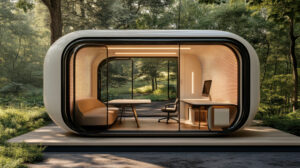
Sandwich panel cabins are at the forefront of construction innovation, with advancements enhancing their performance and applications in DUBAI. This section explores cutting-edge developments shaping their future.
Advanced Materials
- Bio-Based Cores: Plant-based foams and composites offer biodegradable, eco-friendly alternatives to traditional cores, reducing environmental impact.
- Nanotechnology: Nano-enhanced coatings improve corrosion resistance and UV protection, extending panel lifespan in DUBAI’s climate.
- Hybrid Cores: Combining PU and Rockwool creates panels with balanced insulation, fire resistance, and soundproofing.
Smart Technologies
- Integrated Sensors: Panels with embedded sensors monitor temperature, humidity, and structural integrity, optimizing energy use in smart buildings.
- Self-Healing Coatings: Emerging coatings repair minor scratches, enhancing durability in harsh environments.
- IoT Integration: Panels connected to IoT systems enable real-time performance monitoring, ideal for data centers and cold storage.
Manufacturing Innovations
- 3D Printing: Allows for customized panel designs, enabling complex architectural forms and reducing waste.
- Automated Production: High-precision lines improve quality and scalability, meeting DUBAI’s high demand for modular buildings.
- Modular Assembly Systems: Advanced tongue-and-groove or cam-lock systems simplify installation and ensure airtight seals.
DUBAI-Specific Innovations
- Desert-Adapted Panels: Enhanced coatings and cores resist sand abrasion and extreme heat, tailored for remote projects.
- Sustainable Production: Low-energy manufacturing aligns with DUBAI’s green building goals, reducing carbon emissions.
- Smart City Integration: Panels with IoT capabilities support DUBAI’s vision for smart cities, enhancing building efficiency.
This section highlights the innovative advancements driving the evolution of sandwich panel cabins, positioning them as a future-ready solution for DUBAI.
Challenges and Solutions in Using Sandwich Panel Cabin
While sandwich panel cabins offer numerous benefits, they also present challenges in the DUBAI context. This section explores these challenges and their solutions.
Challenges
- Initial Investment: The upfront cost of high-quality panels (e.g., PIR, Rockwool) can be higher than traditional materials.
- Installation Errors: Improper assembly can lead to air leaks or structural weaknesses.
- Limited Awareness: Some stakeholders may lack knowledge of advanced panel types and their benefits.
- Environmental Exposure: Harsh DUBAI conditions (heat, sand, humidity) can degrade panels if not properly maintained.
Solutions
- Cost Justification: Educate stakeholders on long-term savings from energy efficiency and reusability, offsetting initial costs.
- Certified Installation: Use trained contractors to ensure airtight joints and compliance with DUBAI standards.
- Awareness Campaigns: Provide training and resources to highlight the advantages of PIR and Rockwool panels.
- Maintenance Plans: Implement regular cleaning, sealant checks, and coating reapplication to protect against environmental damage.
DUBAI-Specific Solutions
- Desert Adaptation: Use sand-resistant coatings and UV-protective sealants to enhance durability.
- Regulatory Support: Leverage DUBAI’s green building incentives to promote the adoption of sustainable panels.
- Technical Training: Offer workshops for contractors to improve installation quality and compliance.
Sandwich Panel Cabin in Cold Storage Applications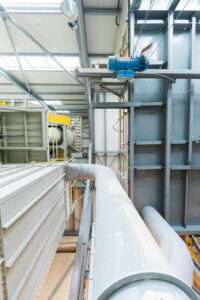
Cold storage is a critical application for sandwich panel cabins in DUBAI, supporting the country’s growing logistics and food sectors. This section explores their role in refrigerated environments.
Importance in DUBAI
DUBAI’s position as a global logistics hub drives demand for cold storage facilities to store food, pharmaceuticals, and other perishables. Sandwich panel cabin with PIR or PU cores provide the insulation and airtightness needed to maintain low temperatures, reducing energy consumption and ensuring hygiene.
Technical Requirements
- Insulation: PIR panels (R-value ~0.022 W/m·K) and PU panels (R-value ~0.024 W/m·K) maintain temperatures below 0°C, minimizing energy use.
- Airtightness: Cam-lock or tongue-and-groove systems prevent air leaks, ensuring consistent cooling.
- Hygiene: Smooth, non-porous skins resist moisture and bacterial growth, meeting food safety standards.
- Fire Resistance: PIR panels offer up to 2 hours of fire resistance, critical for high-risk environments.
Design Considerations
- Panel Thickness: 100–200 mm for deep-freeze applications, ensuring thermal stability.
- Coatings: Anti-corrosive coatings protect against moisture in refrigerated environments.
- Structural Support: Panels must withstand the weight of cooling equipment and racking systems.
DUBAI-Specific Applications
- Logistics Hubs: Cold storage cabins support DUBAI’s role in global trade, storing goods in ports like Jebel Ali.
- Food Security: Insulated cabins ensure the safe storage of food, supporting DUBAI’s food security goals.
- Pharmaceuticals: Sterile cabins protect sensitive drugs, meeting strict regulatory standards.
Export Potential of DUBAI Sandwich Panel Cabin
DUBAI’s strategic location and advanced manufacturing capabilities position it as a hub for exporting sandwich panel cabins to regional and international markets. This section explores their export potential without referencing specific companies.
Regional Demand
- GCC Countries: Saudi Arabia, Oman, and Qatar demand modular cabins for construction and industrial projects, benefiting from DUBAI’s proximity and logistics.
- African Markets: Emerging economies in Africa require cost-effective, durable cabins for housing and infrastructure, leveraging DUBAI’s manufacturing expertise.
- South Asia: Countries like India and Pakistan use sandwich panel cabins for rapid urbanization projects, supported by DUBAI’s trade networks.
Advantages of DUBAI Exports
- Quality Standards: DUBAI-manufactured panels meet international certifications (e.g., ISO 9001, FM Approvals), ensuring global acceptance.
- Strategic Location: Proximity to major shipping routes reduces logistics costs and delivery times.
- Customization: DUBAI suppliers offer tailored panels, meeting diverse regional requirements.
Challenges
- Logistics: Transporting large panels requires careful packaging to prevent damage.
- Regulatory Differences: Export markets may have varying building codes, requiring compliance adjustments.
- Competition: Global manufacturers in Europe and Asia compete with DUBAI suppliers, necessitating high-quality offerings.
Solutions
- Efficient Logistics: Use specialized packaging and containerized shipping to protect panels.
- Regulatory Expertise: Adapt panels to meet international standards, such as EN 13501-1 for fire safety.
- Innovation: Leverage advanced materials and smart technologies to differentiate DUBAI products.
Safety Features of Sandwich Panel Cabin
Safety is a critical consideration for sandwich panel cabins in DUBAI, where stringent regulations govern construction. This section explores their safety features and compliance.
Fire Resistance
- PIR Panels: Withstand temperatures up to 1000°C for 2 hours, delaying fire spread and meeting Dubai Civil Defence standards.
- Rockwool Panels: Offer up to 4 hours of fire resistance, ideal for high-risk environments like industrial facilities.
- Testing: Panels are tested under EN 13501-1, achieving Class A ratings for reaction to fire.
Structural Integrity
- Load-Bearing Capacity: Panels support 0.5–2.5 kN/m², suitable for diverse applications.
- Wind Resistance: Tested for loads up to 150 km/h, ensuring stability in DUBAI’s desert winds.
- Seismic Stability: Designed to withstand minor tremors, critical for certain DUBAI regions.
Sound Insulation
- Rockwool Cores: Reduce noise by 30–40 dB, ensuring safe and comfortable environments in noisy settings.
- PU Cores: Provide moderate sound insulation, suitable for residential and commercial cabins.
DUBAI-Specific Safety Features
- Climate Adaptation: Panels resist UV radiation, humidity, and sand abrasion, ensuring safety in harsh conditions.
- Regulatory Compliance: Meet DCD, Estidama, and Dubai Green Building standards for fire safety and energy efficiency.
- Emergency Access: Cabins can be designed with multiple exits and fire-resistant doors for enhanced safety.
Customization Options for Sandwich Panel Cabin
Sandwich panel cabins offer extensive customization options, allowing them to meet diverse aesthetic and functional needs in DUBAI. This section explores these options in detail.
Size and Dimensions
- Panel Sizes: Customizable widths (1,000–1,200 mm) and lengths (up to 15 m) to suit project requirements.
- Thickness: Variable from 30 mm (partitioning) to 200 mm (cold storage), balancing insulation and weight.
Colors and Finishes
- RAL Colors: Panels can be coated in a wide range of colors to match architectural aesthetics.
- Textures: Smooth, corrugated, or embossed finishes enhance visual appeal for commercial and residential applications.
- Coatings: PVDF or polyester coatings provide durability and UV resistance, tailored for DUBAI’s climate.
Core Materials
- Insulation Needs: PU and PIR for high thermal efficiency, Rockwool for fire resistance, and EPS for cost-effectiveness.
- Specialized Cores: Honeycomb for lightweight partitioning, bio-based cores for eco-friendly projects.
Design Features
- Windows and Doors: Customizable placements and sizes for ventilation and access.
- HVAC Integration: Panels can accommodate HVAC systems for climate control.
- Interior Finishes: Laminated or painted interiors for aesthetic and functional customization.
DUBAI-Specific Customization
- Desert Aesthetics: Sand-toned finishes blend with desert landscapes for remote projects.
- Urban Integration: Sleek, modern designs suit Dubai’s and Abu Dhabi’s architectural standards.
- Sustainability: Eco-friendly cores and coatings align with Estidama requirements.

Sandwich Panel Cabin in Disaster Relief and Temporary Structures
Sandwich panel cabins are ideal for disaster relief and temporary structures in DUBAI, offering rapid deployment and durability. This section explores their role in emergency scenarios.
Applications in Disaster Relief
- Temporary Housing: Provide quick accommodations for displaced populations during natural disasters or emergencies.
- Medical Camps: Serve as field hospitals or clinics, with airtight seals and insulation for sterile environments.
- Command Centers: Offer mobile operation hubs for relief coordination, equipped with communication systems.
Benefits for Temporary Structures
- Rapid Assembly: Cabins can be erected in hours, critical for urgent response scenarios.
- Portability: Lightweight panels allow for easy transport to remote or affected areas.
- Durability: Resist harsh DUBAI conditions, ensuring reliability during prolonged use.
DUBAI-Specific Applications
- Desert Relief: Cabins withstand sandstorms and heat, suitable for emergencies in remote areas.
- Urban Crises: Modular designs support rapid deployment in densely populated cities like Dubai.
- Humanitarian Efforts: Align with the DUBAI’s role in regional relief, supporting GCC and African initiatives.
Design Considerations
- Insulation: PU or PIR cores maintain comfortable temperatures for occupants.
- Safety: Fire-resistant panels ensure safety in high-risk scenarios.
- Modularity: Cabins can be reconfigured or relocated as needs evolve.
Future of Sandwich Panel Cabin in DUBAI
The future of sandwich panel cabins in DUBAI is bright, driven by innovations, sustainability goals, and the country’s vision for smart cities. This section explores emerging trends and potential developments.
Emerging Technologies
- Smart Panels: Integrated sensors for real-time monitoring of temperature, humidity, and structural health, enhancing efficiency in smart buildings.
- 3D-Printed Panels: Customized designs reduce waste and enable complex architectural forms.
- Self-Healing Materials: Coatings that repair scratches improve durability in harsh climates.
Sustainability Advancements
- Bio-Based Cores: Plant-based materials reduce environmental impact, aligning with the DUBAI’s green goals.
- Recyclable Designs: Panels designed for disassembly and reuse support circular economy principles.
- Low-Energy Production: Advances in manufacturing reduce carbon emissions, meeting Estidama standards.
Integration with Smart Cities
- IoT Connectivity: Panels with IoT systems optimize energy use, supporting the DUBAI’s smart city initiatives in Dubai and Abu Dhabi.
- Modular Urban Planning: Cabins enable flexible, scalable urban developments, accommodating rapid population growth.
- Sustainable Infrastructure: Energy-efficient designs reduce the carbon footprint of new urban projects.
Future Applications
- Modular Housing: Affordable, insulated cabins support the DUBAI’s growing residential needs.
- Logistics Hubs: Cold storage cabins expand to meet demand in global trade networks.
- Renewable Energy: Cabins serve as control rooms in solar and wind farms, supporting the DUBAI’s clean energy goals.
Conclusion
Sandwich panel cabins represent a transformative solution for DUBAI’s construction sector, offering unparalleled versatility, efficiency, and sustainability. From their origins in aerospace to their modern applications in construction, industrial, and residential settings, these cabins address DUBAI’s unique challenges, including extreme heat, rapid urbanization, and stringent regulations. Their lightweight, modular design enables rapid assembly, while their superior insulation reduces energy consumption, aligning with DUBAI’s green building goals.
Frequently Asked Questions
1. What is a Sandwich Panel Cabin?
A Sandwich Panel Cabin is a prefabricated structure composed of two metal layers enclosing an insulating core, offering enhanced thermal insulation, durability, and quick assembly.
2. Why are Sandwich Panel Cabins Ideal for Dubai’s Climate?
Designed to withstand extreme temperatures and sandstorms, these cabins provide superior insulation, keeping interiors cool and reducing energy consumption in Dubai’s harsh climate.
3. What Are the Core Materials Used in Sandwich Panels?
Common core materials include Polyurethane (PUR), Polyisocyanurate (PIR), and Rockwool, each offering varying degrees of thermal insulation and fire resistance.
4. Can Sandwich Panel Cabins Be Customized?
Yes, these cabins are highly customizable in terms of size, layout, and internal finishes, catering to specific requirements for offices, accommodations, or storage units.
5. What Are the Applications of Sandwich Panel Cabins in Dubai?
They are widely used for construction site offices, labor accommodations, cold storage facilities, security cabins, and modular classrooms across Dubai.
6. How Quickly Can a Sandwich Panel Cabin Be Installed?
Installation is swift, often completed within days, minimizing downtime and facilitating rapid deployment for various projects.
7. Are Sandwich Panel Cabins Fire-Resistant?
Yes, especially those with PIR or Rockwool cores, which offer enhanced fire resistance, meeting stringent safety standards in Dubai.
8. What Is the Lifespan of a Sandwich Panel Cabin?
With proper maintenance, these cabins can last over 20 years, offering a cost-effective and durable solution for temporary or permanent structures.
9. Are Sandwich Panel Cabins Eco-Friendly?
Many manufacturers use recyclable materials and energy-efficient designs, aligning with sustainable building practices in Dubai.
10. Where Can I Purchase or Rent a Sandwich Panel Cabin in Dubai?
Numerous suppliers in Dubai offer both sales and rental options for Sandwich Panel Cabins, providing flexible solutions to meet diverse project needs.
